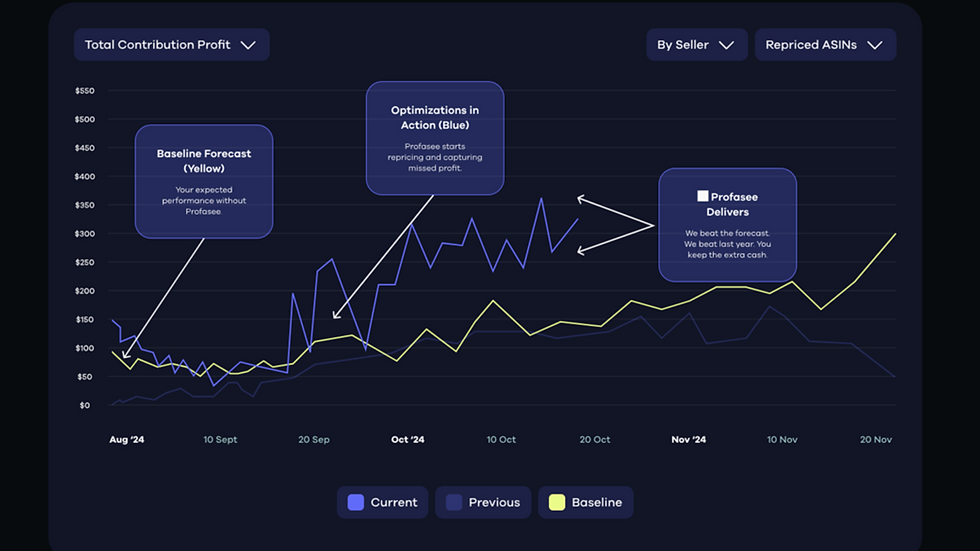How Amazon Seller Loans Accelerate Losses For Low-Profit Sellers
- AccrueMe Team

- Aug 24, 2022
- 4 min read
Updated: Sep 6, 2022
The number one rule of financing is not to borrow money if you don't know how you will pay it back and the same is true for Amazon Seller Loans. Unfortunately for many Amazon Sellers with low profits, Amazon Seller Loans can be the beginning of the end for their Amazon businesses.
The Burn & Grow Fallacy
In recent years, many Amazon PPC Agencies, consultants, and Amazon "gurus" have preached a concept made popular by venture capitalists in Silicon Valley that it is important to grow as quickly as possible regardless of the cost. The idea is that the more you can spend to acquire a customer, the better off you will be in the long run as you increase your market presence and the lifetime value of your Amazon customers.
While this concept may hold true for VC-backed technology companies with access to millions (or even billions) in equity growth capital, it is not the case for almost all Amazon Sellers. The reality is that if an Amazon Selling business is operating at a loss, that loss will eventually have to be covered by the Amazon Seller's owner's equity, an outside equity investor, or a potential acquirer's purchase price.
For example, an Amazon Selling company losing $2,000 per month as a result of excess Amazon PPC and lower Buy Box prices in an effort to gain market share will need an additional $24,000 of outside equity over a year just to maintain its inventory levels. Because Amazon Sellers in growth mode are often undercapitalized, they will turn to Amazon Seller Loans to bridge the gap in buying power caused by their cash burn.
While Amazon Seller Loans can help an Amazon Seller restock their inventory in the short run, if they continue to operate at a loss, the addition of Amazon Seller Financing costs will accelerate losses.
Continuing on the example above, an Amazon Seller losing $24,000 per year borrows $24,000 via an Amazon Seller Loan will now have monthly financing costs (interest and amortization payments) of $2,109.98 (assuming 12-month term, 10% interest, and monthly amortization which are standard terms of an Amazon Seller Loan). In this scenario, an Amazon Seller Loan nearly doubles the cash flow burn for this Amazon Seller which rapidly increases the Amazon Sellers' depletion of their assets leaving the seller severely upside down (more debt than assets) after just a few months.
Amazon Seller Left Holding The Bag
Amazon Sellers will often look for bigger Amazon FBA Loans as their losses accelerate putting them further in debt until they reach the point where they can not refinance their loans or borrow more. At this point, the Sellers are forced to invest more equity capital themselves or find an outside equity investor/acquirer for their Amazon Selling Business.
Continuing on the example above, with $24,000 in financing, the seller will be losing over $4k per month of cash flow. After about four months, that seller will look for an Amazon Seller Loan of $32,000 to cover the $16k in depleted assets over the previous four months plus $16k to cover the remaining balance on their Amazon Seller Loan ($24k initial advance (minus) 4 monthly payments of $2k). But, because this seller has fewer assets than they did when they received the initial $24,000 Amazon Seller loan due to the accelerated negative of cash flow, a new $32k loan will be more expensive or impossible to obtain.
If the Seller does manage to get a more expensive $32,000 Amazon Seller Loan, this downward cycle will continue until the Seller can't refinance and is forced to either
A. Turn a profit,
B. Personally invest additional equity capital to cover the burn rate,
C. Liquidate business assets to repay their loans,
D. Sell the business at a discount and pay their Amazon Seller Loans in full before the Seller receives any of the sale proceeds.
All of these options result in the Amazon Selling business owner coming out of pocket to cover all of the losses and financing costs of the business up until the time they reach this point.
Conclusion
Running an Amazon Selling Business at a loss is something that should only be done for the short-term (primarily only when launching the business). Running at a loss long term can only be done if the Amazon Seller or equity investors in the seller have deep pockets to sustain a loss-based burn and grow model.
Financing for Amazon Sellers is not a solution to a non-profitable business model and Amazon Seller Loans will not help sellers solve the cash flow problems of a non-profitable business.
For non-profitable Amazon Businesses, Amazon Seller Loans will only accelerate losses and result in the business owners "holding the bag" by being forced to personally finance the losses and financing costs at some point.
About AccrueMe®
AccrueMe provides success-based capital for Ecommerce. With decades of experience in lending, AccrueMe's leaders have created a completely new way of providing capital, powered by a proprietary portal built around leading-edge eCommerce technology. With unprecedented line of sight into business data, AccrueMe’s portal simplifies financing for online retailers in a way that was never before possible: based entirely on sellers' success, and repaid when best for the seller, and not based upon a pre-determined schedule. Ecommerce retailers have built their businesses on the latest technology, we believe they deserve financing from a partner that's powered the same way. AccrueMe: cutting edge capital for eCommerce. Learn more at AccrueMe.com






Comments